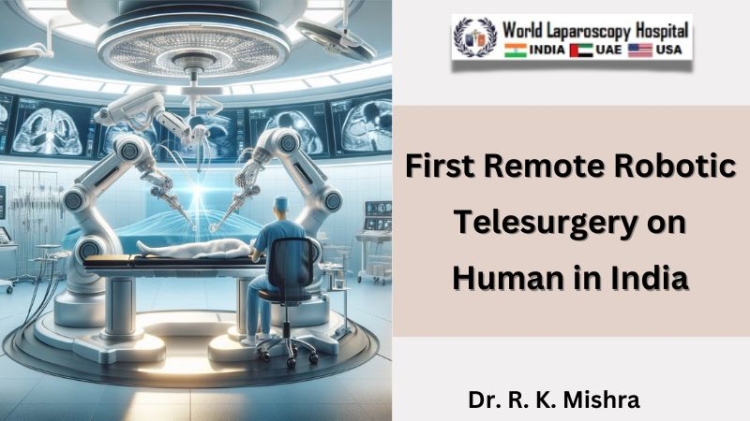In the ever-evolving field of medical technology, few milestones have been as groundbreaking as the first remote robotic telesurgery performed on a human in India. This historic event, which took place at the World Laparoscopy Hospital (WLH) using Mantra Robot, not only marked a significant achievement in the realm of minimally invasive surgery but also set a new benchmark for the future of surgical care worldwide.

The Evolution of Telesurgery
Telesurgery, the ability to perform surgical procedures on a patient from a remote location, leverages advanced telecommunications technology and robotic systems. This innovative approach bridges the gap between patients and highly specialized surgical expertise, offering numerous benefits, especially in regions with limited access to advanced medical care. The concept of telesurgery has been in development for decades, with significant progress made in the early 21st century. The introduction of robotic-assisted surgery, particularly the Mantra Robotic Surgical System, revolutionized the field by providing surgeons with enhanced precision, flexibility, and control.
World Laparoscopy Hospital: A Pioneer in Minimally Invasive Surgery
World Laparoscopy Hospital, located in Gurugram, India, has been at the forefront of laparoscopic and robotic surgery education and practice. Under the visionary leadership of Dr. R.K. Mishra, the hospital has established itself as a global center of excellence, training thousands of surgeons from around the world in advanced minimally invasive techniques. WLH's commitment to innovation and excellence made it the ideal setting for India's first remote robotic telesurgery. The hospital's state-of-the-art facilities and experienced surgical team provided the necessary infrastructure and expertise to undertake this groundbreaking procedure.
The Historic Surgery
The first remote robotic telesurgery performed in India at WLH involved a highly complex procedure. Utilizing the Mantra Surgical System, the surgery was conducted by Dr. R.K. Mishra from a remote location, while the patient was situated in the operating room at WLH. The seamless integration of advanced robotic technology and high-speed internet connectivity ensured that the procedure was executed with utmost precision and efficiency. The surgery was a success, demonstrating the immense potential of telesurgery in expanding access to high-quality surgical care. It also highlighted the capability of WLH to serve as a hub for cutting-edge surgical innovations.
Technical Aspects and Execution
The success of this surgery was underpinned by a combination of advanced technologies. The Mantra Robotic Surgical System, known for its precision and minimally invasive approach, played a crucial role. This robotic system provides surgeons with a 3D high-definition vision system, which enhances their ability to perform complex procedures with greater accuracy. Additionally, the robotic arms of the Mantra system are capable of mimicking the human hand's dexterity but with even greater precision, reducing the risk of errors.
The communication infrastructure was equally critical. High-speed internet connectivity facilitated real-time data transmission, ensuring that every movement and command from the remote surgeon was executed without delay. This real-time interaction was crucial for the success of the surgery, as it allowed for instantaneous adjustments and responses to the patient's condition.
Implications and Future Prospects
The successful execution of India's first remote robotic telesurgery has far-reaching implications for the future of healthcare. It opens up new possibilities for providing expert surgical care to patients in remote or underserved areas, reducing the need for travel and associated costs. This breakthrough also paves the way for more collaborative efforts in the medical community, enabling surgeons to share expertise and perform complex procedures across geographical boundaries.
Furthermore, the success of this surgery underscores the importance of ongoing investment in telecommunication infrastructure and robotic technology. As these technologies continue to advance, the potential for telesurgery to become a standard practice in medical care grows exponentially.
Challenges and Considerations
While the success of this pioneering surgery is undoubtedly a cause for celebration, it also brings to light several challenges and considerations. Ensuring the reliability and security of the telecommunication infrastructure is paramount. Any lag or interruption in communication could have serious implications for the patient's safety. Moreover, the cost of advanced robotic systems and the necessary communication technology can be prohibitive, particularly for healthcare institutions in developing countries.
There are also regulatory and ethical considerations. Clear guidelines and protocols need to be established to govern the practice of remote surgery, ensuring that patient safety and confidentiality are maintained at all times. Additionally, the training of surgeons in both robotic surgery and the use of remote communication tools is essential to ensure the successful implementation of telesurgery.
Conclusion
The first remote robotic telesurgery in India, performed at World Laparoscopy Hospital, represents a monumental achievement in the field of minimally invasive surgery. It showcases the incredible potential of modern technology to transform healthcare delivery and improve patient outcomes. As WLH continues to lead the way in surgical innovation, this landmark event will undoubtedly inspire further advancements and collaborations in the global medical community.
The journey of telesurgery is just beginning, and with continued technological advancements and collaboration, the dream of providing world-class surgical care to every corner of the globe is becoming a reality. The success at WLH serves as a beacon of what is possible and sets the stage for an exciting future in the world of medicine.
